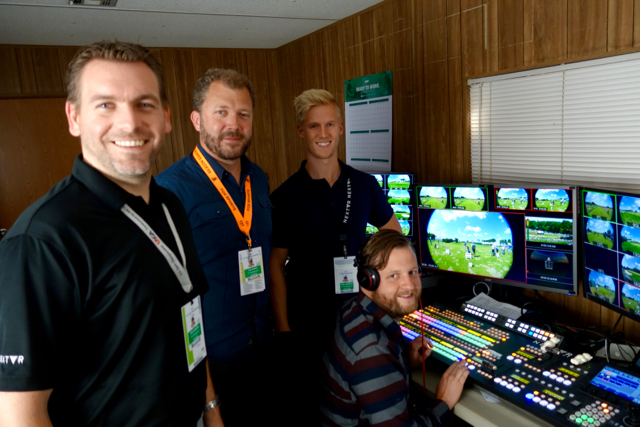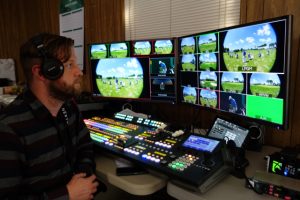Live From the U.S. Open: NextVR Takes VR to Next Level With Eight Cameras, Directed Feed
Story Highlights
Last year Next VR was on hand at the U.S. Open in what was little more than an experimental role as the company, and Fox Sports, worked together to find out the best way to produce a golf major in VR. This year’s U.S. Open sees the fruits of those efforts (and many other efforts since then) as Ryan Sheridan, NextVR, SVP, imaging and production technologies, says that eight Red Digital cameras are being used to cover four holes tee to green and the practice range in VR.

NextVR’s Ryan Sheridan, DJ Roller, Jared King, and Tim Amick are helping Fox Sports deliver an eight-camera VR production from the U.S. Open.
“The signals are send back to the compound uncompressed and are then encoded and sent out to the world,” he says.
The most unique aspect of the production is that Next VR is actually offering users the ability to tune into a produced feed that will teleport them around the course to make sure they don’t miss any of the action. That offering took months to develop as many in the VR industry have preached that cutting from one VR camera to the next is a no-no as the viewer would find it disorienting.
“It works great,” says Sheridan of cutting multiple VR cameras. “We truly believed it was possible but we wanted to try it out and vet it first. The first few times we just wanted to see if it was technically possible and then we needed to figure out the production things we needed to do to make it work. It’s taken some months to perfect but we learned the best practices.”
Among those practices? First, find the proper moment to make the cut and take the viewer to another camera.
“Then you need to make sure there is black for a moment so that the viewer can reset their mental context,” he explains. “You don’t want to do a hard cut, wipe, or dissolve. Also the brain recognizes audio first so do an audio transition dissolve.”

NextVR’s Tim Amick plays a key role in the production of the U.S. Open this weekend.
The audio side of VR has also been improved since last year as the VR audio mixer has access to the binaural feed from the camera’s mic, effects mics deployed by NextVR, and effects mics from the main show, like the cups, crowds, and other mics.
“One gigantic mic at the top of the camera may be technically correct but it’s not ideal and it’s not how people want to experience sports in VR. So the idea is to enhance the audio without breaking reality or making it annoying.”
Roller calls the audio approach “hybrid binaural” as a separate mix for each camera and that next-generation app technology will allow for full psychoacoustic positional mixing in a live/realtime environment for each camera that is deployed.
“The app will apply the head position track and spatialization to the mix for each camera and render that to the user’s headphones.
“We’ve done a lot of shows in the past year and it all culminates in this which is the largest VR show we’re aware of in the U.S. so we’re pretty proud and happy with this,” says Sheridan. “This sets a new benchmark and from here we just move up.”
One of the things that will help in those efforts to move up will be the rollout of a dedicated VR production truck later this summer. DJ Roller, Next VR co-founder, says that one of the goals with both the truck and the overall production efforts in general is to make it easier for any broadcast production professional to be a part of a VR production without feeling lost and intimidated.
“We want to keep the productions growing and scaling and this event proves that the blueprint is now working because we can scale,” he says. “And it’s designed so that our team does not need to be at every production.”
As for the truck, Roller says the priority is making sure it is just right.
“That truck is the test bed that proves out what we said about making VR scalable,” he says. “We aren’t trying to get into the truck rental business so we will work with vendor partners.”
In addition, there are future developments like the work NextVR is doing with Qualcomm on the development of the Snapdragon chip. For example, patrons can show up at the U.S. Open and get a google cardboard and watch action around the course. Or location data could be integrated so that the VR experience would be closely aligned to where the fan is located.
But for this weekend the focus is on the U.S. Open and its potential.
“We do live instant gratification and every minute we’re learning new things and applying it to the production,” he says. “And the options are limitless as we grow this show.”
